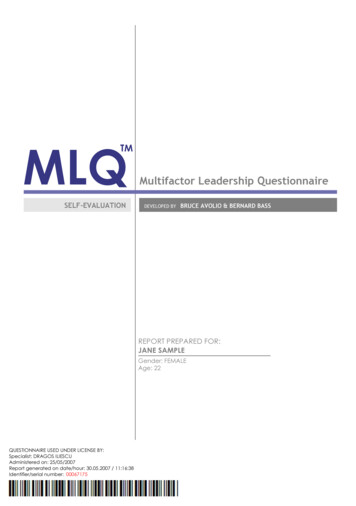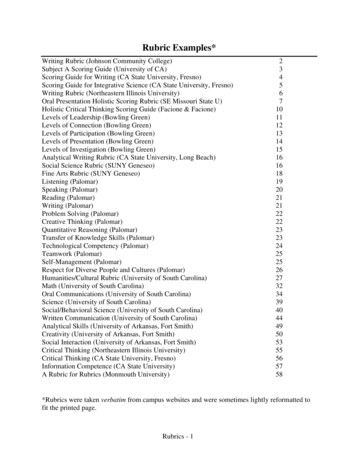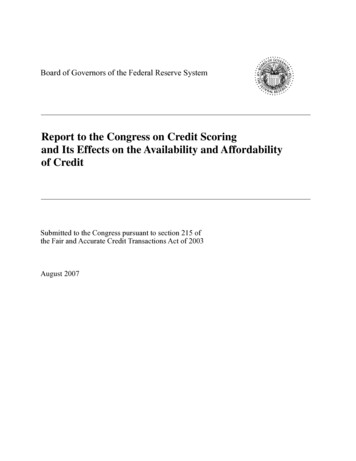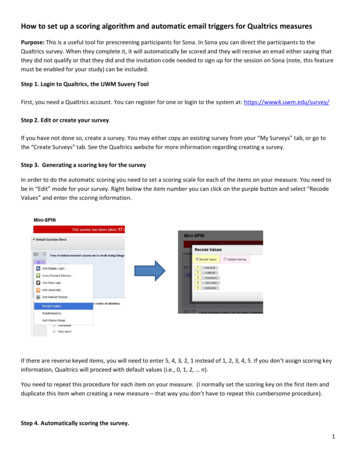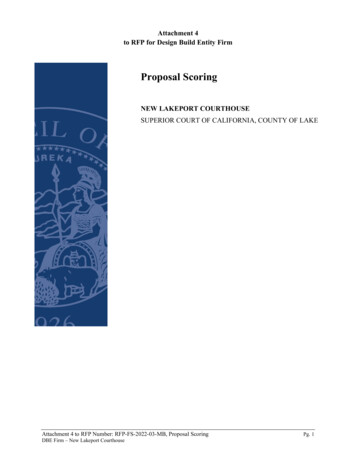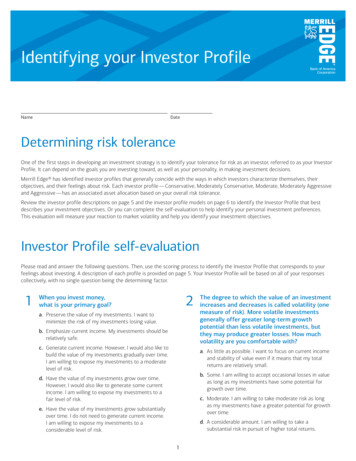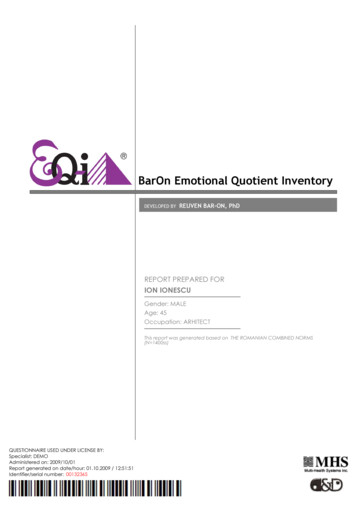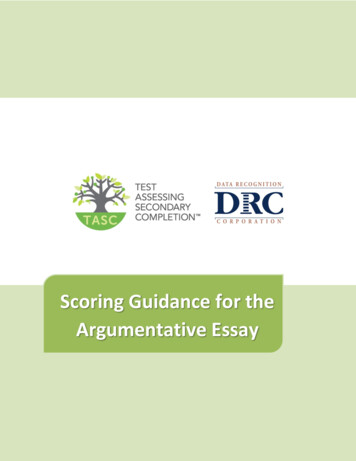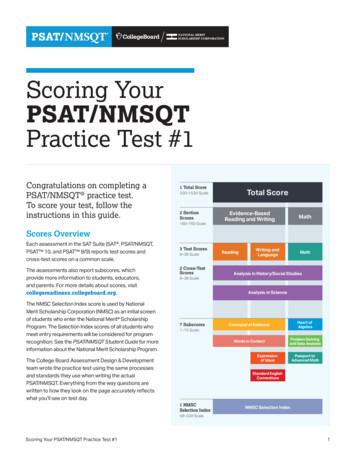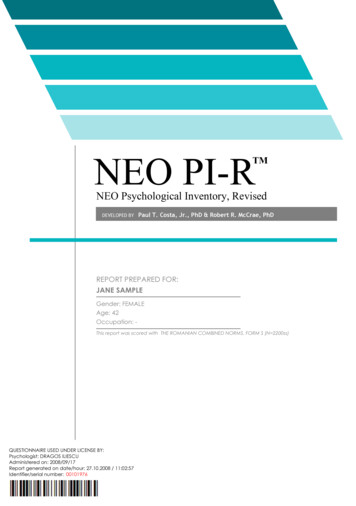
Transcription
TMNEO PI-RNEO Psychological Inventory, RevisedDEVELOPED BYPaul T. Costa, Jr., PhD & Robert R. McCrae, PhDREPORT PREPARED FOR:JANE SAMPLEGender: FEMALEAge: 42Occupation: This report was scored with THE ROMANIAN COMBINED NORMS, FORM S (N 2200ss)QUESTIONNAIRE USED UNDER LICENSE BY:Psychologist: DRAGOS ILIESCUAdministered on: 2008/09/17Report generated on date/hour: 27.10.2008 / 11:02:57Identifier/serial number: 00101976
1This report helps in better understanding key personality traits of the evaluated person. Thedescription is based on the five key factors comprised in the Big Five personality model.This report has been developed for the use of psychologists, counseling staff and other types ofspecialized professionals, in their work with their clients.Paul T. Costa, Jr., Ph.D. & Robert R. McCrae, Ph.D.NEO Personality Inventory, Revised (NEO PI-R)IntroductionAlthough structured as a stand-alone report, which especially in the second section (detailedreport) may also be easily read by persons not trained in the usage of psychological tests, thisreport has been projected and developed in such a way as to offer assistance to the professionalwho is interpreting the test results.These results should only be considered in conjunction with professional judgment, after acareful and detailed analysis, and only after corroborating these data with the results of aninterview and of possible other psychometric instruments. Results contained in this report may besubject to alterations and special highlights as a function of such corroborations, made by aspecialized professional.This report is based on NEO PI-R, a psychometric instrument that has been validated in a widevariety of research programs.The NEO PI-R (NEO Psychological Inventory, Revised) is a structured, verbal, omnibus measureof normal personality. The questionnaire consists in 240 items, grouped in 5 meta-factors, eachhaving six distinct facets, characteristic for the Big Five model of personality.What information may be found in this report?In addition to this introductory section, the report contains four big sections:1. The NEO PI-R Summary,2. The NEO PI-R Profile,3. The NEO PI-R Detailed Report,4. The Modus Operandi details.Each of these sections will begin with explanations about the meaning of the differentdata they offer.
2YourSummaryIt does, however, give you some idea aboutwhat makes you unique in your ways of thinking,feeling, and interacting with others.This summary is intended to give you ageneral idea of how your personality might bedescribed. It is not a detailed report. If youcompleted the inventory again, you might scoresomewhat differently. For most individuals,however, personality traits tend to be very stable inadulthood. Unless you experience major lifechanges or make deliberate efforts to changeyourself, this summary should apply to youthroughout your adult life.Compared with the responses of other people, your responses suggest that you can bedescribed as:Paul T. Costa, Jr., Ph.D. & Robert R. McCrae, Ph.D.NEO Personality Inventory, Revised (NEO PI-R)The NEO inventory measures five broaddomains or dimensions of personality. Theresponses that you gave to the statements aboutyour thoughts, feelings, and goals can be comparedwith those of other adults to give a description ofyour personality.For each of the five domains, descriptions aregiven below for different ranges of scores. Thedescriptions that are checked provide descriptionsof you, based on your responses to the inventoryitems.The NEO inventory measures differencesamong normal individuals. It is not a test ofintelligence or ability, and it is not intended todiagnose problems of mental health or adjustment.Sensitive, emotional, andprone to experience feelingsthat are upsetting.Generally calm and able todeal with stress, but yousometimes experience feelingsof guilt, anger or sadness.Secure, hardy, and generallyrelaxed even under stressfulconditions.Extraverted, outgoing, active,and high-spirited. You preferto be around people most ofthe time.Moderate in activity andenthusiasm. You enjoy thecompany of others but youalso value privacy.Introverted, reserved, andserious. You prefer to be aloneor with a few close friends.Open to new experiences. Youhave broad interests and arevery imaginative.Practical but willing toconsider new ways of doingthings. You seek a balancebetween the old and the new.Down-to-earth, practical,traditional, and pretty much setin your ways.Compassionate, good-natures,and eager to cooperate andavoid conflict.Generally warm, trusting, andagreeable, but you cansometimes be stubbord andcompetitive.Hardheaded, skeptical, proud,and competitive. You tend toexpress your anger directly.Conscientious andwell-organized. You have highstandards and always strive toachieve your goals.Dependable and moderatelywell-organized. You generallyhave clear goals but are able toset your work aside.Easygoing, not verywell-organized, and sometimescareless. Your prefer not tomake plans.
ThePaul T. Costa, Jr., Ph.D. & Robert R. McCrae, Ph.D.NEO Personality Inventory, Revised (NEO PI-R)3ProfileThe next page contains the NEO PI-R profile. This is a graphical representation of the scorescharacteristic for the evaluated person for the five factors and 30 facets measured by the NEOPI-R.The 35 scales are graphically grouped from left to right, so that the five factor scores arepresented first, followed by each of the six facets of every factor. The profile visually groups thefactor scales and the facets so that the clusters are easily differentiated.The profile is accompanied by both the numerical value of the data, and their graphicrepresentation. All the scales are presented so that the high scores are placed in the upper side ofthe graphic, and the low scores are placed in the lower side of the graphic. This is a generalprocedure in the visual representation of scores from the NEO PI-R and from other tests thatreport data in standardized (T) scores.The NEO PI-R profile indicates, in the upper side, under the name of each scale, the raw scoreobtained for the scale in discussion. The profile is generated on the basis of this raw score, but itvisually presents standardized T scores.The T scores are standardized scores that take into account the scores obtained by other personsin the normative sample that has been used for the scoring of the test. The T scores have a meanof 50 and a standard deviation of 10. This means that a T score of 50 places the evaluated personat the mean of the normative sample. A volume of 67% of all the T scores fall between 40 and60. Theoretically it is not possible to have T scores below 20 or above 80, and that is the reasonwhy the visual profile does not show these intervals.The profile also marks five intensity categories for each score. The interval 20-35 indicatesVERY LOW scores. The interval 35-45 indicates LOW scores. The interval 45-55 indicatesAVERAGE scores. The interval 55-65 indicates HIGH scores. The interval 65-80 indicatesVERY HIGH scores.This profile has been scored with: THE ROMANIAN COMBINED NORMS, FORM S (N 2200ss)
Very 242526272095Anxiety (N1)AngryHostility(N2)Depression (N3)SelfConsciousness(N4)Impulsiveness (N5)3012345678910111213141516171819202122232425th (E11011121314151617181920212223242526272829303120 king (E5)otions 29307 Excite)15 Warm32regariousness (E2)rtiveness 303126 s (O4)17 11121314151617181920212223242526272829309 Trust 04050607080Low2030100158sitiveEm21 Po3)gs (O18 Feelinlity (N6)erabiVuln13Asse24Neuroticism(N)Extraversion (E)Openness(O)Agreeableness (A)Conscientiousness 4Average4050607080O5)11 Ideas((O6)22 Values4)ity (EActiv13ightforwardA1)16 Stra(O2)eticsAesthy (O1)6pliance (A4)sty (A5)14 Comtence(C1)10 Order(A6)derMindedness11 Tenism (Altru18Mode20Compe18(C2)17Paul T. Costa, Jr., Ph.D. & Robert R. McCrae, Ph.D.16Dutifulness (C3)AchievementStriving (C4Self)Discipline (C5)ration(C6)16Delibe6NEO Personality Inventory, Revised (NEO PI-R)HighLowVery highVery low4Very low
ThePaul T. Costa, Jr., Ph.D. & Robert R. McCrae, Ph.D.NEO Personality Inventory, Revised (NEO PI-R)5Detailed ReportThe detailed report offers a drilldown of the characteristics ascertained through the NEO PI-Rand already pictured in the NEO PI-R profile. The charts and the comments presented in thisbroader section are also based on the norms selected at the scoring of the test and indicated in theintroductory part of the profile.This section has been developed by psychologists in such a way as to offer assistance to theprofessionals who interpret the results and to minimize the reverting to the test manual.This section may also be read by the evaluated person as part of a structured discussion with thepsychologist or of a personal development program the evaluated person is part of. However,conclusions should be drawn on the basis of this report only after discussing the data with aspecialized professional and only in conjunction with other data, obtained from other evaluations,like other structured assessments, qualitative inquiries etc.The detailed section contains for each of the NEO PI-R scales one chart capturing both the rawscores (below) and the standardized T scores (above), with a special marker where the evaluatedperson’s score has been computed. Also, below every chart one may read a short description ofthe scale, in order to understand the interpretative frame of the score. Some adjectivaldescriptions associated with the low and the high scores of the scale are also presented.If the evaluated person obtains on a certain scale a high score, then there is a high probability thatthe person is to be described by the descriptions suggested for the high scores. The higher thescore is, the more characteristic these descriptions are for the evaluated person. The same thinghappens for low scores: the lower the score is, the more characteristic for the evaluated personare the typical descriptions for low scores.Only the facet scales of the five factors of the NEO PI-R are represented in this section. Theirorder they are discussed in is the same with the order of visualisation in the NEO PI-R profile.
6THE FACETS OF NEUROTICISM (N)N1 Anxiety2025Raw Score: 22T Score: 63Percentile: 903035404550556065707580T ScoreT ScoreRaw ScoreRaw Score12345678910 11 12 13 14 15 16 17 18 19 20 21 22 23 24 25 26 27 28 29 30Anxious people are shy, fearful, nervous, tensed and restless. This scale does not measure specific fears orphobias, but high scorers are more likely to have such fears, as well as free-floating anxiety. On the other hand,low scorers are calm and relaxed.Adjectives associated with high scoresanxious, worried, concerned, tensed, nervousN2 Angry Hostility202530Raw Score: 17T Score: 56Percentile: 7335404550556065707580T ScoreT ScoreRaw ScoreRaw 28This facet represents the tendency to experience anger and negative emotions, such as frustration andbitterness. This scale measures the individual’s readiness to experience anger. Its expression depends uponindividual’s level of Agreeableness. Disagreeable persons often score high on this scale. Low scorers areeasygoing and slow to anger.Paul T. Costa, Jr., Ph.D. & Robert R. McCrae, Ph.D.NEO Personality Inventory, Revised (NEO PI-R)Adjectives associated with low scorestrustful, optimisticAdjectives associated with low scoresgentileAdjectives associated with high scoresrestless, irritable, anxious, excitable, moody, tensedN3 Depression202530Raw Score: 12T Score: 46Percentile: 3435404550556065707580T ScoreT ScoreRaw ScoreRaw Score12345678910 11 12 13 14 15 16 17 18 19 20 21 22 23 24 25 26 27 28 29This scale measures normal individual differences in the tendency to experience depressive affect. High scorersare prone to feelings of guilt, sadness, hopelessness, and loneliness. They are easily discouraged and oftendejected. Low scorers rarely experience such emotions, buy they are not necessarily cheerful and lighthearted,this positive characteristics being associated instead with Extraversion.Adjectives associated with low scoressatisfied, trustful, confidentAdjectives associated with high scoresworried, pessimistic, indisposed, anxious
7N4 Self-Consciousness20253035Raw Score: 11T Score: 39Percentile: 14404550556065707580T ScoreT ScoreRaw ScoreRaw The emotions of shame and embarrassment form the core of this facet of N. Self-conscious individuals areuncomfortable around others, sensitive to ridicule, and prone to feelings of inferiority. Self-consciousness is akinto shyness and social anxiety, described by Fenigstein, Scheier and Buss (1975). Low scorers do not necessarilyhave poise or good social skills, but they are simply less disturbed by awkward social situations.Adjectives associated with high scoresself-conscious, shy, distrustful, defensive, , inhibited,anxiousN5 Impulsiveness202530Raw Score: 20T Score: 62Percentile: 8835404550556065707580T ScoreT ScoreRaw ScoreRaw n the NEO PI-R, impulsiveness refers to the inability to control cravings and urges. Desires or yearnings (for food,cigarettes, possessions, a.s.o) are perceived by the high scorers as being so strong that the individual cannotresist them, although he or she may later regret the behavior. Low scorers find it easier to resist suchtemptations, having a high tolerance for frustration and the capacity to easier postpone gratifications. The termimpulsive is used by many theorists to refer to many different and unrelated traits. Therefore, NEO PI-Rimpulsiveness should not be confused with spontaneity, risk-taking, or rapid decision time.Paul T. Costa, Jr., Ph.D. & Robert R. McCrae, Ph.D.NEO Personality Inventory, Revised (NEO PI-R)Adjectives associated with low scoresconfidentAdjectives associated with low scorescontrolledAdjectives associated with high scoresmoody, irritable, sarcastic, self-centered, noisy,hasty, excitableN6 Vulnerability202530Raw Score: 13T Score: 54Percentile: 6635404550556065707580T ScoreT ScoreRaw ScoreRaw Score12345678910111213141516171819202122232425The final facet of N is vulnerability to stress. Individuals who score high on this scale feel unable to cope withstress, becoming dependent, hopeless, or panicked when facing emergency situations. Low scorers perceivethemselves as capable of handling themselves in difficult situations and often have a healthy feeling of trust intheir adaptive abilities.Adjectives associated with low scoreslucid, confident, trustful, operative, vigilantAdjectives associated with high scoresnegligent
8THE FACETS OF EXTRAVERSION (E)E1 Warmth2025Raw Score: 15T Score: 34Percentile: 53035404550556065707580T ScoreT ScoreRaw ScoreRaw 2Warmth is the facet of Extraversion most relevant to issues of interpersonal intimacy. Warm people areaffectionate and friendly. They genuinely like people and easily form close attachments to others. Low scorersare neither hostile nor necessarily lacking in compassion, but they are more formal, reserved, and distant inmanner than high scorers. Warmth is the facet of E that is closest to Agreeableness in interpersonal space, but itis distinguished by a cordiality and heartiness that is not part of Agreeableness.Adjectives associated with high scoresfriendly, kind, sociable, glad, affectionate,open-heartedE2 Gregariousness202530Raw Score: 20T Score: 55Percentile: 6935404550556065707580T ScoreT ScoreRaw ScoreRaw Score45678910 11 12 13 14 15 16 17 18 19 20 21 22 23 24 25 26 27 28 29 30 31 32The second aspect of E is gregariousness, that is the preference for other people’s company. Gregarious peopleenjoy the company of others, and the more the merrier. Low scorers on this scale tend to be loners who do notseek, or even actively avoid social stimulation.Paul T. Costa, Jr., Ph.D. & Robert R. McCrae, Ph.D.NEO Personality Inventory, Revised (NEO PI-R)Adjectives associated with low scoresdistantAdjectives associated with low scoresdistant, withdrawnAdjectives associated with high scoressociable, open-hearted, epicurean, talkative,spontaneousE3 Assertiveness202530Raw Score: 24T Score: 67Percentile: 9635404550556065707580T ScoreT ScoreRaw ScoreRaw 29High scorers on this scale are dominant, forceful, and socially ascendant. They speak without hesitation andoften become group leaders. Low scorers prefer to keep in the background and let others do the talking, comeup with ideas and propositions, assign tasks and lead group projects.Adjectives associated with low scoresshyAdjectives associated with high scoresaggressive, dominating, confident, strong, enthusiastic
9E4 Activity2025Raw Score: 13T Score: 37Percentile: 103035404550556065707580T ScoreT ScoreRaw ScoreRaw 0High scorers is characteristic to people who have a rapid tempo in life. These persons are vigorous, energetic andneed to be always busy. Active people lead fast-paced lives. Low scorers are more leisurely and relaxed intempo, although they are not necessarily sluggish or lazy.Adjectives associated with high scoresenergetic, hurried, fast, decided, enthusiastic,aggressive, activeE5 Excitement-Seeking20253035Raw Score: 7T Score: 30Percentile: 2404550556065707580T ScoreT ScoreRaw ScoreRaw 2930High scorers on this scale crave exciement and stimulation. They like bright colors and noisy environments.Excitement-Seeking is akin to some aspects os sensation seeking (Zuckerman, 1979). Low scorers feel little needfor thrills and prefer a life that high scorers might find boring.Paul T. Costa, Jr., Ph.D. & Robert R. McCrae, Ph.D.NEO Personality Inventory, Revised (NEO PI-R)Adjectives associated with low scorespassive, inactiveAdjectives associated with low scorescontrolled, withdrawn, puritanAdjectives associated with high scoresepicurean, bold, adventurous, charming, presentable,courageous, smartE6 Positive Emotions20253035Raw Score: 21T Score: 55Percentile: 69404550556065707580T ScoreT ScoreRaw ScoreRaw 031The last facet of E assesses the tendency to experience positive emotions such as joy, happiness, love, andexcitement. High scorers on the Positive Emotions scale laugh easily and often. They are cheerful and optimistic.Low scorers are not necessarily unhappy; they are merely less exuberant and high-spirited. Research (e.g. Costa& McCrae, 1980a) has shown that happiness and life satisfaction are related to both N and E, and that PositiveEmotions is the facet of E most relevant to the prediction of happiness.Adjectives associated with low scorespessimistic, depressedAdjectives associated with high scoresenthusiastic, waggish, bragging, spontaneous,epicurean, optimistic, cheerful
10THE FACETS OF OPENNESS (O)O1 Fantasy2025Raw Score: 26T Score: 72Percentile: 993035404550556065707580T ScoreT ScoreRaw ScoreRaw 9Individuals who are open to fantasy have a vivid imagination and an active fantasy life. They daydream notsimply as an escape but as a way of creating for themselves an interesting inner world. They elaborate anddevelop their fantasies and believe that imagination contributes to a rich and creative life. Low scorers are moreprosaic and prefer to keep their minds on the task at hand.Adjectives associated with high scoresdreamy, imaginative, waggish, roguishly, idealistic,artistic, complicatedO2 Aesthetics2025Raw Score: 6T Score: 25Percentile: 13035404550556065707580T ScoreT ScoreRaw ScoreRaw Score45678910 11 12 13 14 15 16 17 18 19 20 21 22 23 24 25 26 27 28 29 30 31 32High scorers on this scale have a deep appreciation for art and beauty. They are moved by poetry, absorbed inmusic, and intrigued by art. They need not have artistic talent, nor even necessarily what most people wouldconsider good taste; but for many of them, their interest in the arts will lead them to develop a wider knowledgeand appreciation than that of the average individual. Low scorers are relatively insensitive to and uninterested inart and beauty.Paul T. Costa, Jr., Ph.D. & Robert R. McCrae, Ph.D.NEO Personality Inventory, Revised (NEO PI-R)Adjectives associated with low scoreswell-grounded, realisticAdjectives associated with low scoresrealisticAdjectives associated with high scoresimaginative, artistic, original, enthusiastic, inventive,idealistic, versatileO3 Feelings2025Raw Score: 18T Score: 46Percentile: 343035404550556065707580T ScoreT ScoreRaw ScoreRaw 1Openness to feelings implies receptivity to one’s own inner feelings and emotions and the evaluation of emotionas an important part of life. High scorers experience deeper and more differentiated emotional states and feelboth happiness and unhappiness more intensely then others. Low scorers have somewhat blunted affects and donot believe that feeling states are of much importance.Adjectives associated with low scoreswithdrawn, non affectionateAdjectives associated with high scoresexcitable, spontaneous, introspective, imaginative,affectionate, talkative, open-hearted
11O4 Actions2025Raw Score: 17T Score: 54Percentile: 663035404550556065707580T ScoreT ScoreRaw ScoreRaw ss is seen behaviorally in the willingness to try different activities, go new places, or eat unusual foods.High scorers on this scale prefer novelty and variety to familiarity and routine. Over time, they may engage in aseries of different hobbies. Low scorers find change difficult and prefer to stick with the tried-and-true.Adjectives associated with high scorescurious, imaginative, adventurous, optimistic,talkative, open-hearted, versatileO5 Ideas2025Raw Score: 11T Score: 34Percentile: 53035404550556065707580T ScoreT ScoreRaw ScoreRaw 303132Intellectual curiosity in an aspect of Openness that has long been recognized (Fiske, 1949). This trait is seen notonly in an active pursuit of intellectual interests for their own sake, but also in open-mindedness and awillingness to consider new, perhaps unconventional ideas. High scorers enjoy both philosophical arguments andbrain-teasers. Openness to ideas does not necessarily imply high intelligence, although it can contribute to thedevelopment of intellectual potential. Low scorers on the scale have limited curiosity and, even when highlyintelligent, narrowly focus their resources on limited topics.Paul T. Costa, Jr., Ph.D. & Robert R. McCrae, Ph.D.NEO Personality Inventory, Revised (NEO PI-R)Adjectives associated with low scoresmoderateAdjectives associated with low scoresdisinterested, conservativeAdjectives associated with high scoresidealistic, interested, curious, original, imaginative,introspectiveO6 Values2025Raw Score: 22T Score: 58Percentile: 793035404550556065707580T ScoreT ScoreRaw ScoreRaw penness to Values means the readiness to reexamine social, political, and religious values. Closed individualstend to accept authority and honor tradition and as a consequence are generally conservative, regardless ofpolitical party affiliation. Openness to Values may be considered the opposite of dogmatism (Rokeach, 1960).Adjectives associated with low scoresconservative, cautiousAdjectives associated with high scoresunconventional, rakish
12THE FACETS OF AGREABILITY (A)A1 Trust2025Raw Score: 9T Score: 30Percentile: 23035404550556065707580T ScoreT ScoreRaw ScoreRaw 303132The first facet of Agreeableness is Trust. High scorers have a disposition to believe tat others are honest andwell-intentioned. Low scorers on this scale tend to be cynical and skeptical and to assume that others may bedishonest or dangerous.Adjectives associated with high scoresforgiving, credulous, peacefulA2 Straightforwardness20253035Raw Score: 16T Score: 44Percentile: 27404550556065707580T ScoreT ScoreRaw ScoreRaw Score45678910 11 12 13 14 15 16 17 18 19 20 21 22 23 24 25 26 27 28 29 30 31 32Straightforward individuals, that is, those individuals with high scores on this scale are frank, sincere, andingenuous. Low scorers on this scale are more willing to manipulate others through flattery, craftiness, ordeception. They view these tactics as necessary social skills and may regard more straightforward people asnaive. When interpreting this scale (as well as other A and C scale), it is particularly important to recall thatscores reflect standing relative to other individuals. A low scorer on this scale is more likely to stretch the truthor to be guarded in expressing his or her true feelings, but this should not be interpreted to mean that he or sheis a dishonest or manipulative person. In particular, this scale should not be regarded as a lie scale, either forassessing the validity of the test itself, or for making prediction about honesty in employment or other settings.Paul T. Costa, Jr., Ph.D. & Robert R. McCrae, Ph.D.NEO Personality Inventory, Revised (NEO PI-R)Adjectives associated with low scoressuspicious, cautious, pessimistic, insensitiveAdjectives associated with low scorescomplicated, pretentious, manipulative, unsettling,misleading, artful, despoticAdjectives associated with high scoresconstant, sincereA3 Altruism202530Raw Score: 18T Score: 43Percentile: 2435404550556065707580T ScoreT ScoreRaw ScoreRaw 132High scorers on the Altruism scale have an active concern for others’ welfare as shown in generosity,consideration of others, and a willingness to assist others in need of help. Low scorers on this scale are somewhatmore self-centered and are reluctant to get involved in the problems of other.Adjectives associated with low scoresegocentricAdjectives associated with high scorescordial, pitiful, gentile, generous, gentle, tolerant
13A4 Compliance202530Raw Score: 14T Score: 43Percentile: 2435404550556065707580T ScoreT ScoreRaw ScoreRaw This facet of Agreeableness concerns characteristic reactions to interpersonal conflict. The high scorer tends todefer to others, to inhibit aggression, and to forgive and forget. Compliant people are meek and mild. The lowscorer is aggressive, prefers to compete rather than cooperate, and has no reluctance to express anger whennecessary.Adjectives associated with high scoressensible, tolerantA5 Modesty2025Raw Score: 20T Score: 57Percentile: 763035404550556065707580T ScoreT ScoreRaw ScoreRaw 930High scorers on this scale are humble and self-effacing although they are not necessarily lacking inself-confidence or self-esteem. Low scorers believe they are superior people and may be considered conceited orarrogant by others. A pathological lack of modesty is part of the clinical conception of narcissism.Paul T. Costa, Jr., Ph.D. & Robert R. McCrae, Ph.D.NEO Personality Inventory, Revised (NEO PI-R)Adjectives associated with low scoresobstinate, demanding, stubborn, anxious, impatient,intolerant, brutal, insensitiveAdjectives associated with low scoresaffected, manipulative, assertive, quarrelsome,confident, aggressive, idealisticAdjectives associated with high scoresmodestA6 Tender-Mindedness20253035Raw Score: 11T Score: 28Percentile: 1404550556065707580T ScoreT ScoreRaw ScoreRaw 1This facet scale measures attitudes of sympathy and concern for others. High scorers are moved by others’ needsand emphasize the human side of social policies. Low scorers are more hardheaded and less moved by appeals topity. They would consider themselves realists who make rational decis
NEO Personality Inventory, Revised (NEO PI-R) Paul T. Costa, Jr., Ph.D. & Robert R. McCrae, Ph.D. 4 20 20 30 30 40 40 50 50 60 60 70 70 80 80 Very high High Average Low Very low Very low Low Average High Very high 146 144 142 140 138 136 134 132 130 128 126 124 122 120 118 116 114 112 110 108 106 104 102 100 98 96 94 92 90 88 86 84 82 80 78 76 74 72 70 68 66 64 62 60 58 56 54 52 50 48 46 44 42 .

